|
|
Post by bixaorellana on Jul 19, 2010 8:31:24 GMT
There is always a feeling of anticipation when arriving at one of the big weekly markets. Ocotlán's is one of the largest and oldest in the central valleys of Oaxaca. 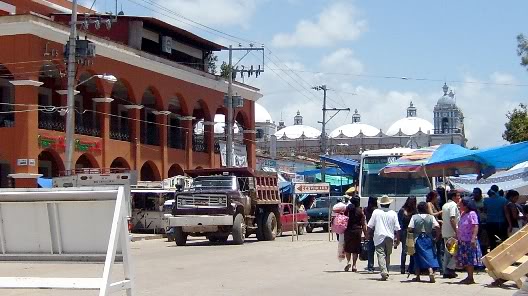  As you can see, the area is beautifully dominated and framed by the Wedgwood blue and white domes and spires of the town's famous church. It's well into mid-day, and some of these people are heading back home. Even though the bus and truck area is big, it gets really crowded on market day. No point in standing out here in the glare and traffic. Time to step up to the cool greenery of the main square. I can look down on some of the clay ware for sale there in the bus area. This stuff comes from Atzompa, another town near Oaxaca which supplies much of the everyday bowls, plates, pitchers, etc. Those pitchers are for making hot chocolate. The stick protruding from one is the handle of a molinillo. |
|
|
|
Post by bixaorellana on Jul 19, 2010 8:32:51 GMT
The whole area surrounding the square is also given over to the market ~ 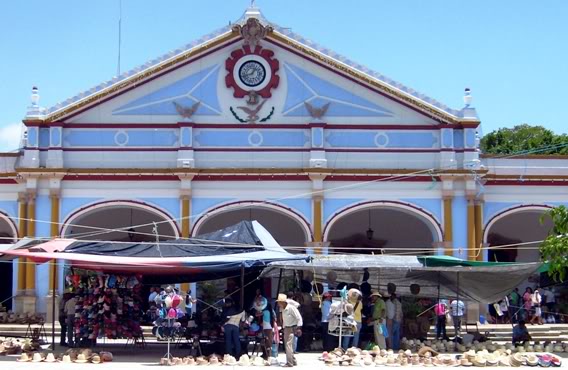 Let's get closer and check out the hats and maybe buy a beverage. 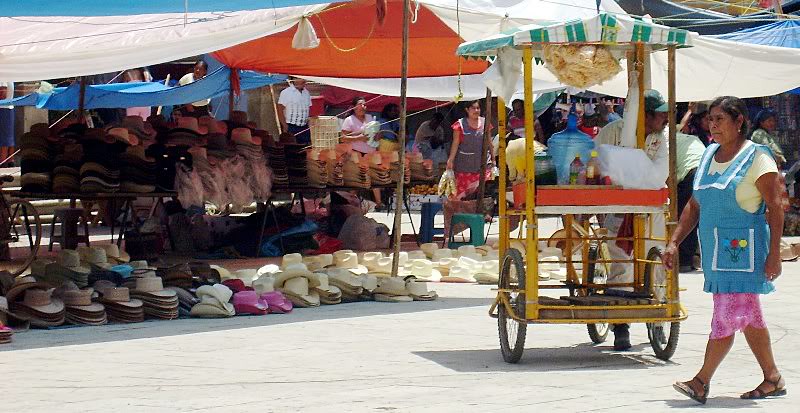 If you plan on buying much of that crockery, you'd better get one of these baskets to pack it all in. 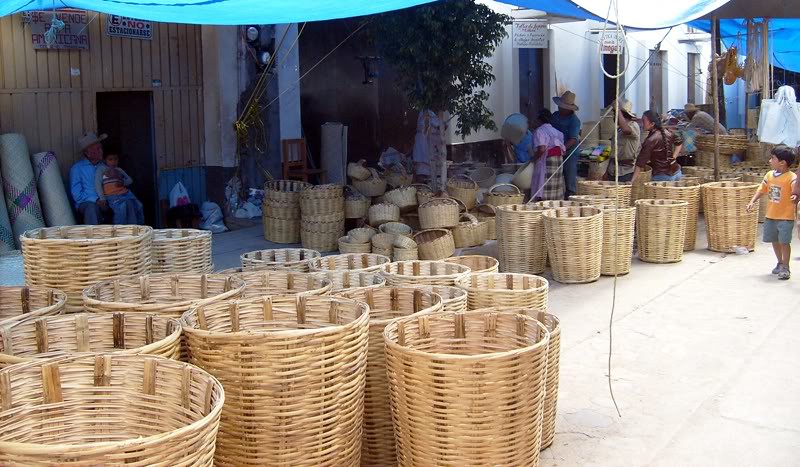 And there will be other opportunities for basket buying of any size or shape. 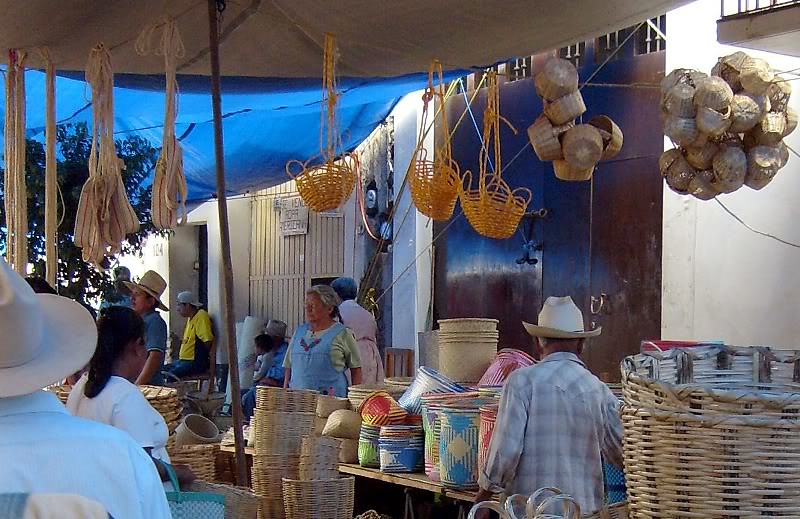 The utilitarian stuff is necessary and attractive in its way, but I want to look at the pretty things. Before plunging deeply into the market, let's look at a few of the stalls around the bandstand. As mentioned in part one of our visit to this area, one of the local crafts is embroidery. If you have an interest in this subject, I highly recommend Bob Freund's website. He is sensitive and knowledgeable, and the site is a goldmine of history and cultural explanations. I fell hard for these blouses. They're heavily embroidered in a variety of styles on lightweight unbleached muslin. I only asked the price of one (the red one on the bottom) & was told 300 pesos, so @25 usd without bargaining.  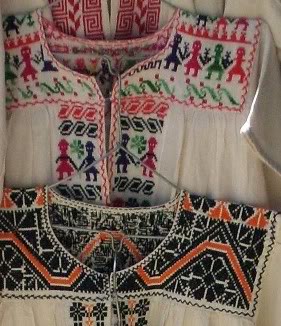 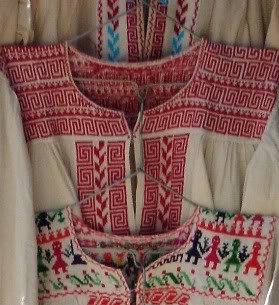 There were also examples of the weaving from Teotitlan del Valle, rugs, purses, tablecloths and runners, even coasters. 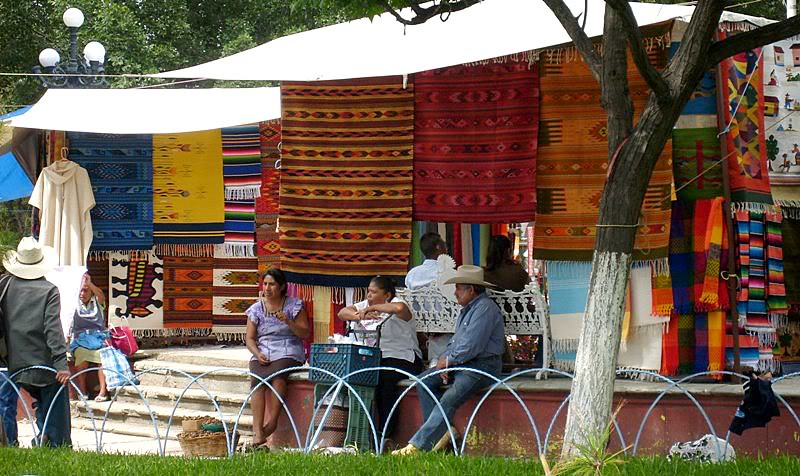 There is much more to see. You all just wander around and look for now. When I come back, we'll plunge into the interior of the market. And after that, there will be a very special treat! |
|
|
|
Post by spindrift on Jul 19, 2010 9:41:47 GMT
Mmmm..... I feel as if I'm there  |
|
|
|
Post by bjd on Jul 19, 2010 9:53:14 GMT
I love those markets, Bixa -- the colours, the noise.
|
|
|
|
Post by Deleted on Jul 19, 2010 13:04:23 GMT
My gripe with markets like that is that they seem to have so many things that one would want to buy -- even when you don't need anything!
I was also wondering how far away is the day when the people won't be dressed as 'typical Mexicans' anymore in places like Oaxaca. Already in Mexican films that take place in Mexico City or anywhere along the northern border, the clothes are indistinguishable from what is worn on other continents. And I imagine that some of these dignified ladies with their embroidered blouses and serious braids have daughters in tight jeans and t-shirts and weird hair.
|
|
|
|
Post by bixaorellana on Jul 19, 2010 19:42:51 GMT
So is everyone ready to penetrate a little further into the market? There is so much of everything. Tons of produce, of course, but I think I've covered that exhaustively in some of my other market pictures, along with the meat. You'll need something to cook all your meats and vegetables in ~ 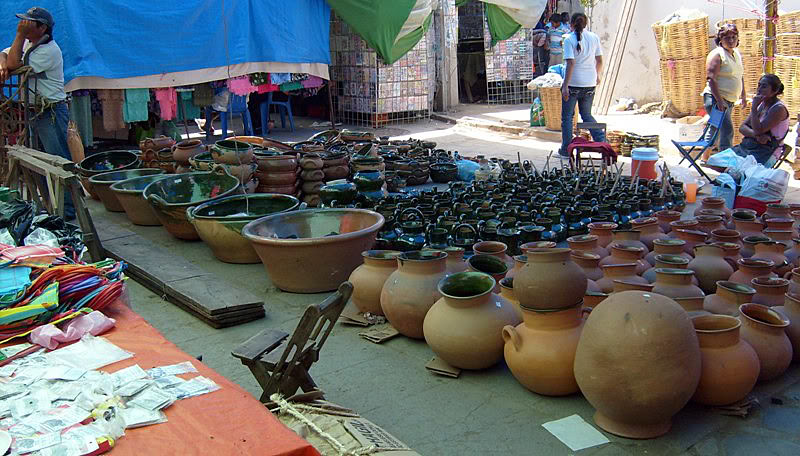 Those are bean pots in the foreground, except for the ones with no interior glaze. You can see an unglazed one atop that pot with handles. See the little holes around the rim? That's so it can be hung. It can be made into a piñata or used for filtering water. Beyond the bean pots are a selection of the chocolate or coffee pots, and you'll see the handles of molinillos sticking out of the ones towards the back. The great big containers are also for cooking. You can find even bigger ones, too. These are always to be found at parties, where mole, soup, beans, and rice are made for the crowd. Next to them are the cazuelas -- the casseroles/pots that are a ubiquitous part of the Mexican kitchen. I love this lady. I wonder what she's thinking, as she pensively fingers that non-traditional blouse. Surely the slight stretchiness and breathability of the fabric must be appealing to her. 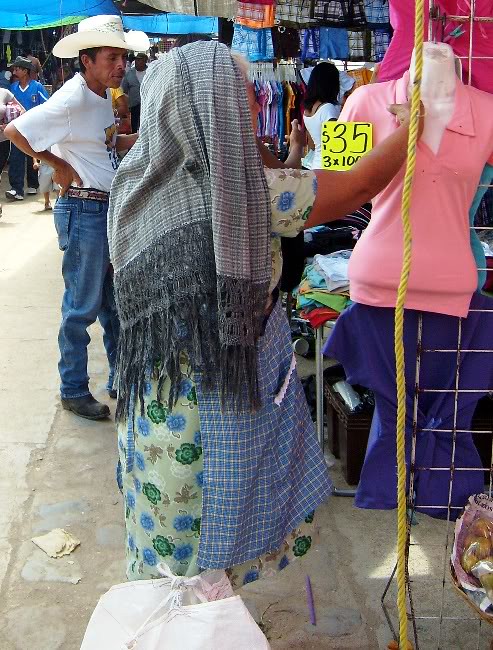 She seems to be wearing a fairly conventional dress. However, many of the women in that satiny blouse with skirt combination have on another blouse underneath. Apparently that is the original and traditional use of the embroidered blouses shown in Reply #1 above. Kerouac mentioned the inevitability of traditional dress passing away. For women, at least, I don't see that happening any time soon in Mexico. Except for festivals, where they're in "costume", it is extremely rare to see a man in traditional clothing, and then it will be a very old man. But all over southern Mexico you will see women and girls in either full "traje" or a strong and universal usage of part of it. You'll notice how many women in these pictures have a rebozo, even though it's a hot day. And remember that they're from all over the surrounding area, not just this town. The pinafore is such a common part of women's garb here, it can be considered part of the traditional clothing canon. One day I'll make a report on Tlacolula, whose market is a kaleidescope of colorful traditional dress-wearers. Mezcal, a liquor distilled from agave, is produced all over the the valleys of Oaxaca. This family seems rather avid in their interest in it. I don't know what all the additions are, but the green-tinted one with leaves is most likely cedrón -- lemon verbena. The round things are probably nance, a tropical fruit. Those may be sticks of sugar cane in some of the bottles. |
|
|
|
Post by bixaorellana on Jul 19, 2010 19:43:25 GMT
Why, my goodness! I'm sure I recently heard some anyporters say they needed parts for their old sewing machines. What have we here? 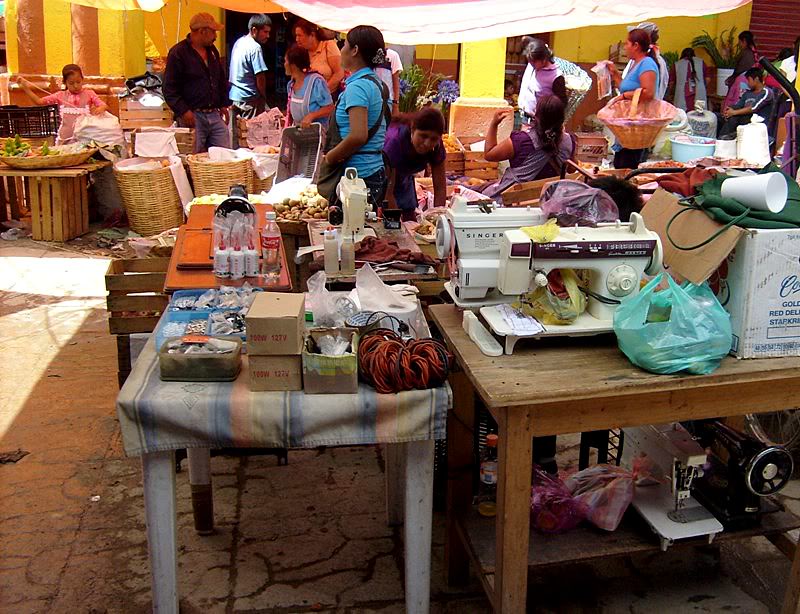 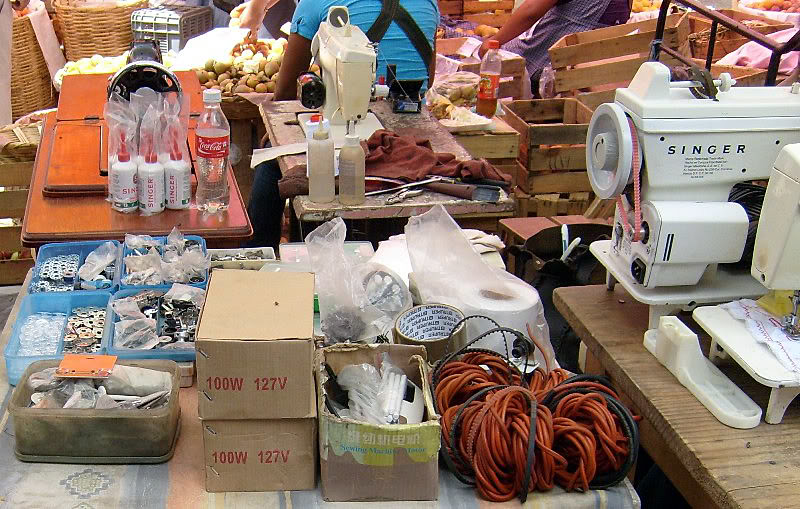 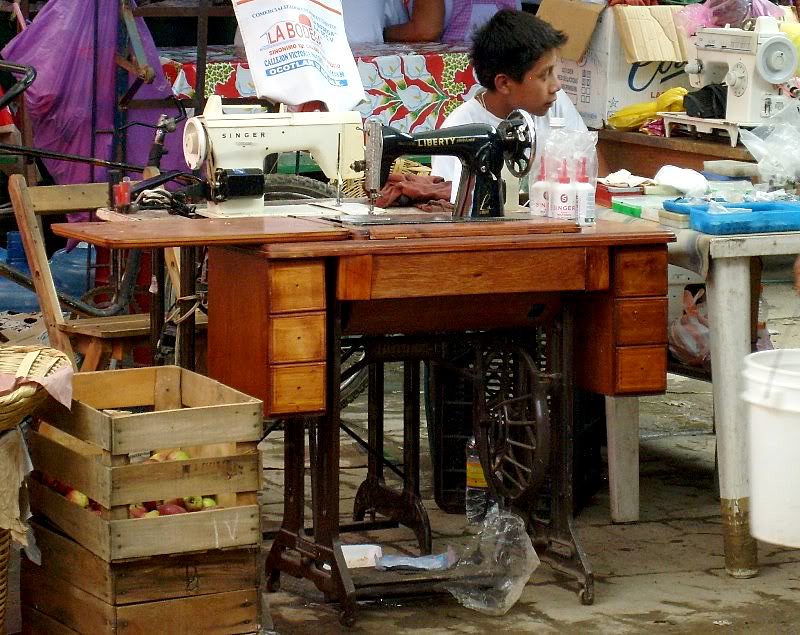 Even though all the overhead tarps and the various walls and arches make it feel like indoors, we are still outside the permanent market. Let's keep going, then we'll step inside the market building. |
|
|
|
Post by bixaorellana on Jul 19, 2010 19:44:12 GMT
And of course, there is food galore to be had. Everything from full meals in ad hoc eateries ~ 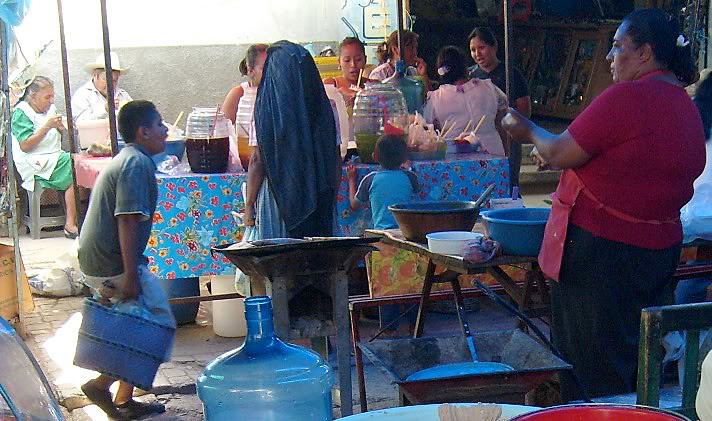 To snacks, both savory and sweet ~ 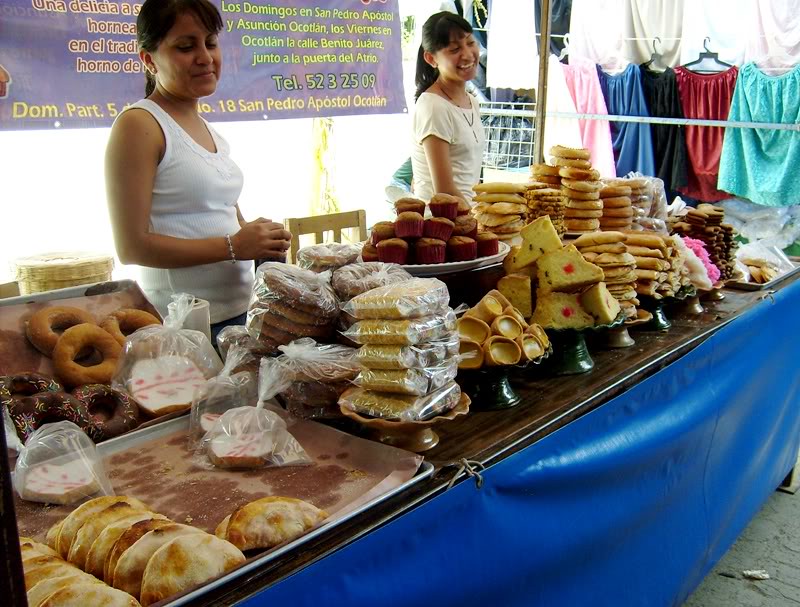 Those big cakes squares left of center on the front of the table are mamones -- eggy cake soaked with a sugary glaze. I adore them, but wisely forbore this time. You can see the bees happily feasting on them, though. If you didn't buy a natural fruit-ade from the girls in the top picture, maybe you'd like a tejate. This drink of elaborate preparation is purely pre-Hispanic. 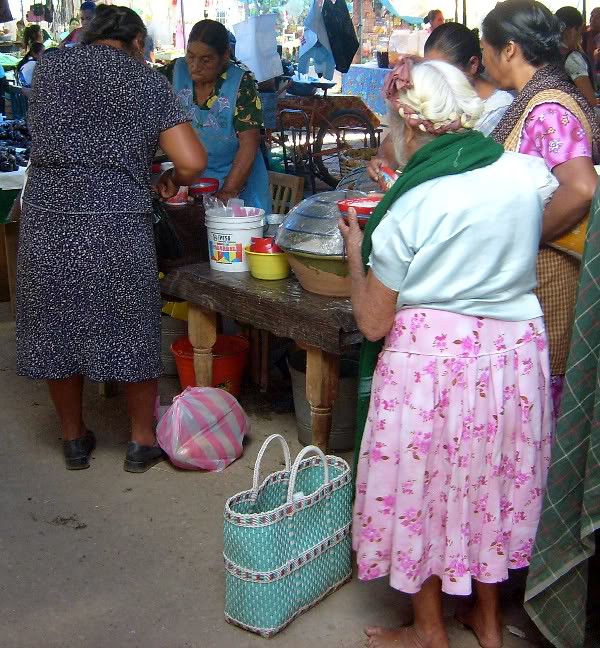 It is traditionally drunk from a red-painted gourd, and locals swear that's how it tastes best. 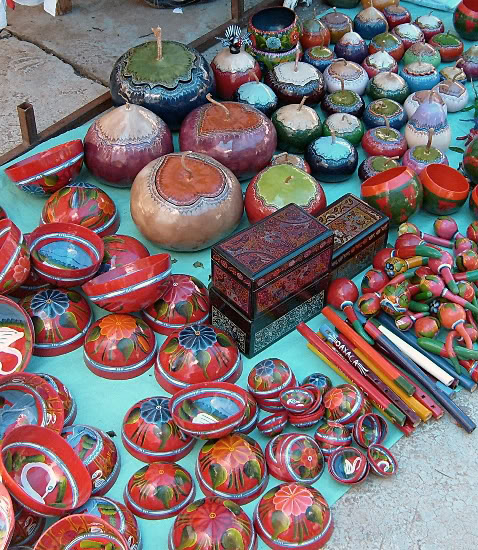 It's sweet, rich, and refreshing. I'm vicariously enjoying it through this lady, who took her time and really savored it. 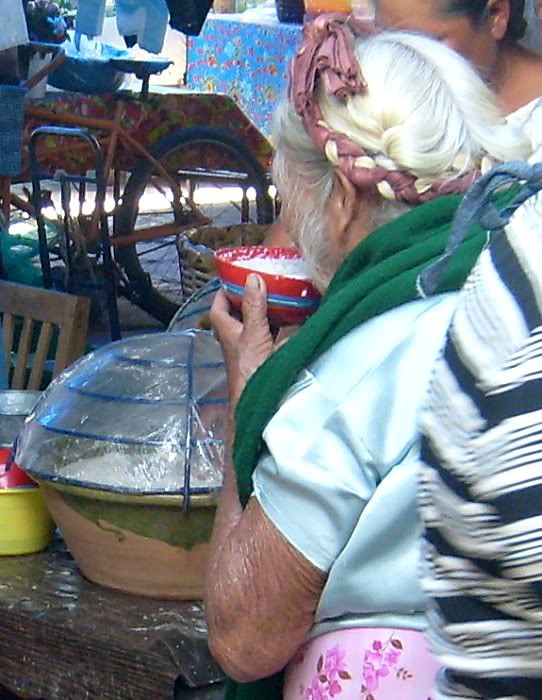 You all must be getting a little tired by now. Let's go outside and wander towards the church -- the glory of Ocotlán. We're approaching it now, as it's close to the municipal building. This scene is reproduced all over Mexico on market days, when people take advantage of the cool floor and arched shade to wait out the day. 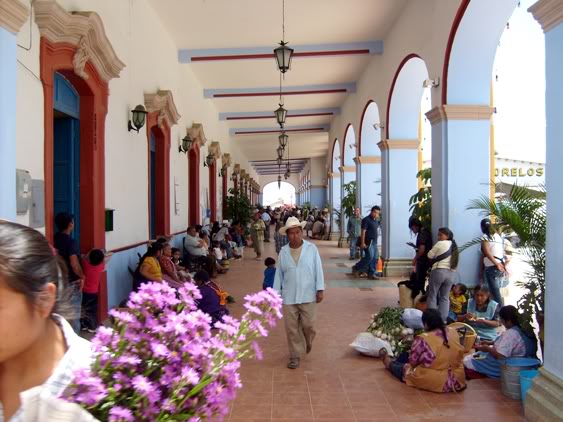 Just by the one of the gates into the huge churchyard, is this bench and window onto the grounds ~ 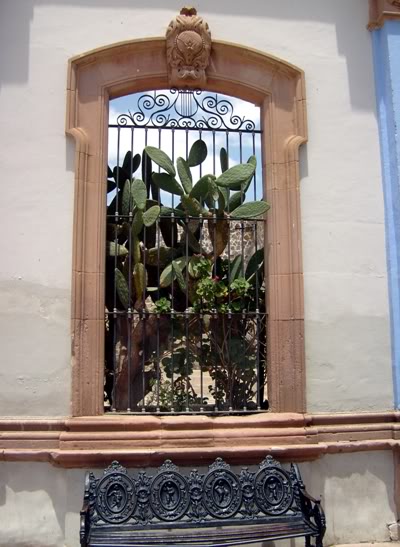 With three entrances and lots of benches, you can see it's a good place to hang out. Later we'll go inside the church itself, an exquisite jewel lovingly restored under the auspices of the painter Rodolfo Morales. 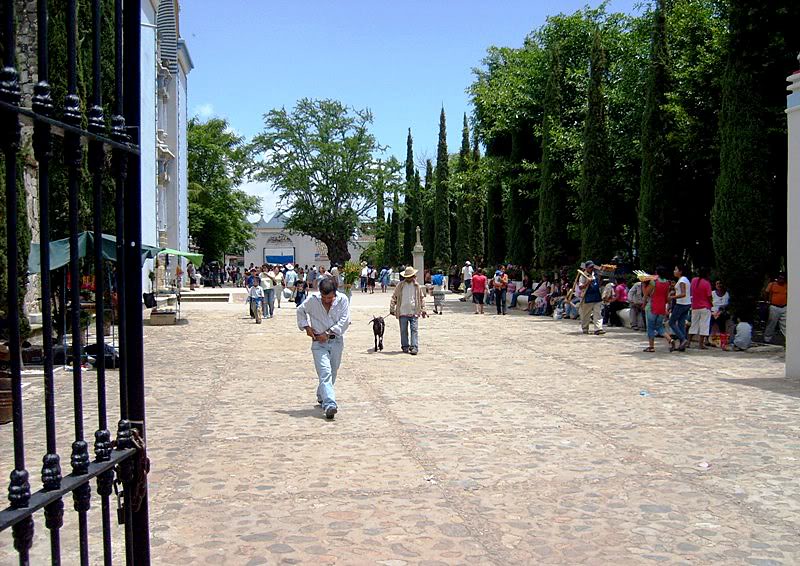 Click on the photo above to be taken to the church! Click on the photo above to be taken to the church! |
|
|
|
Post by hwinpp on Jul 22, 2010 1:57:56 GMT
Wonderful colours!
Is this a weekly market or is it on everyday?
|
|
|
|
Post by bixaorellana on Jul 22, 2010 2:20:28 GMT
I thought about you while I was there, HW! (then I reeeeally thought about you on Monday, when I wound up at the mezcal festival!) There is some market activity there every single day, but all of these towns, and even neighborhoods in the city, have a set day for a more elaborate market. Ocotlán's is always on a Friday. This kind of weekly market is called a tianguis or día de plaza, depending on where you are in Mexico. You might enjoy this article, which explains the history and set-up of these markets. Also, one of the photos is of Tzintzuntzan, near where Don Cuevas lives, and another is of Zaachila, which all my anyport pals know because you accompanied me there during the days of the dead. Be sure to go look at Ocotlán's incredible church, please! anyportinastorm.proboards.com/index.cgi?action=display&board=mexico&thread=4281&page=1#85839 |
|
|
|
Post by hwinpp on Jul 22, 2010 2:58:24 GMT
Thanks for the tianguis link. Seeing the picture of the covered street made me smile. We've got that kind of market here as well.
|
|
|
|
Post by bixaorellana on Jul 22, 2010 22:37:57 GMT
I love looking at your photos of the markets in southeast Asia, HW, especially the ones around where you live in Cambodia. This kind of market is a bridge from the past into the present, and gives a glimpse into other people's lives we might not have otherwise. Since the weekly markets take place all over, you can see the same vendors at the different tianguis. Friday in Ocotlán I ran into a family of fruit vendors whom I know from both the Abastos and the Zaachila markets. Many vendors get up pre-dawn to get to the market and set up. Others are contract labor for long days and low pay under tiring conditions. For instance, most paleta vendors are old men. The strolling vendors, their hands holding more than seems possible, keep moving through the crowds, entire stores and cash registers on foot. 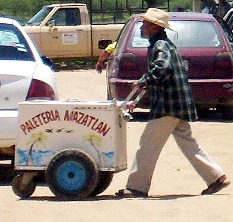 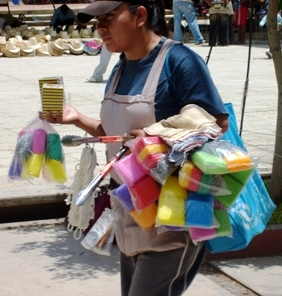 And they will stop and patiently hold up their wares, enumerating their products' virtues, pointing out variety, or ferreting out unseen treasures from the tangle, offering to show more and exhorting you to buy.  I would like to know how they maneuver all of this. Do they bring a certain amount to the market on a given day, or is there a truck or someplace nearby where they can restock throughout the day? Whatever, it's a hell of a way to make a living. 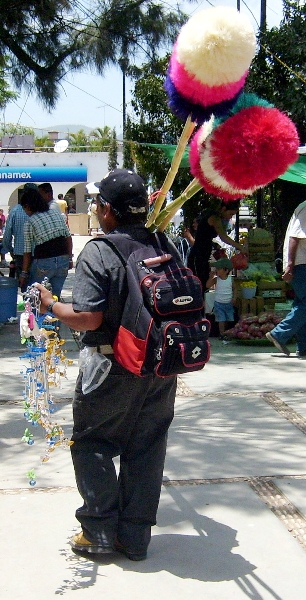 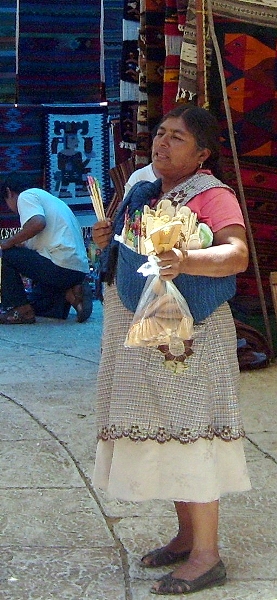 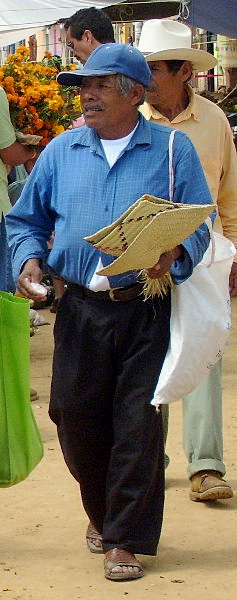 |
|
|
|
Post by bixaorellana on Jul 22, 2010 22:38:37 GMT
That's not to say stationary vendors have it easy, however. They're stuck in one spot all day, liable to lose business if they need to go off to the bathroom. There's the endless sorting and rearranging of the product, the attempts to protect products from being damaged, the calling out of wares, the haggling, the attempts to convince skeptical customers. And for the women, especially, there are frequently children along who must be cared for in the midst of the workday. |
|
|
|
Post by Deleted on Jul 23, 2010 16:59:23 GMT
Although most -- but not all! -- of the markets in Paris could be considered to be more sophisticated, I too am in continual amazement and perplexity about storing the goods, setting them up, bringing out what is not immediately visible when requested, and then putting at all away and/or carting it off at the end of the market. What a bunch of tedious work!
In terms of fruits and vegetables, a certain amount must be discarded every day. It is generally carefully placed in boxes and crates next to the "trash" so that the needy can help themselves. This is not done with meat or fish or products like that which could give food poisoning -- but I'm sure that there is a method for giving some of it away also.
Do Mexican markets work the same way? Is much stuff thrown away?
|
|
|
|
Post by bjd on Jul 23, 2010 17:06:04 GMT
What are paletas? The guy pushing the paleteria looks like an ice-cream vendor.
|
|
|
|
Post by bixaorellana on Jul 28, 2010 7:19:22 GMT
Oh -- sorry for not answering the last two posts!
If you go to several markets within a week, you'll see lots of the same vendors, since they travel from market to market. When I was in this market, I was greeted by a family of fruit vendors whom I know from both the Zaachila and the Abastos markets. That's one of the reasons I like to buy my produce from the Abastos on Tuesday, because that's the day the vendors stock up as well. When I go to the Zaachila market on Thursday, I'm buying Tuesday's tomatoes, for instance. All of that is to say that I think the vendors take any produce that's still good with them to sell another day.
People are kind of fiends for fresh meat here, so I'm pretty sure any pork that's not sold that day is turned into chorizo, and much beef is hung up to dry.
I don't know if anything gets distributed to the poor or not. I do know that markets create huge mounds of trash and it's miraculous how it's cleaned up when the market is over for the day. I used to live in a house where a Saturday market set up right in front. When I awoke on Saturdays, it was all there as if by magic. And on Saturday those same vendors who'd been working all day, went over the area like ants, not a scrap was left. On Sunday morning it was as though they'd never been there.
You got it, Bjd! Yes, paletas can be either lollipops or frozen treats on a stick, which are always made with natural ingredients.
|
|
|
|
Post by bixaorellana on Sept 15, 2010 16:05:15 GMT
I tried from afar to get a good photo of the Frida Kahlo look-alike lady, but didn't get a crisp picture. She's in the video in Reply #6 at the 1:11 mark. A repeat of the still picture in the video:  |
|
|
|
Post by Jazz on Sept 16, 2010 1:48:27 GMT
Gorgeous day at the market! You give a very full sense of the day…if you play the video in #6 and then look again at the photos, you have a sound track as you move through the market... Interesting that the women continue to wear traditional clothing. Somehow I think that this will go on, not for the ‘quaintness’ but for sheer practicality. Your video of the church is beautiful. (for a non religious person, I have spent infinite hours in churches around the world, they offer a cool place to sit, are serene, and offer wonderful art and architecture.) The photo of the Frida look-alike is amazing, one of my favorite photos of the real Frida Kahlo, |
|
|
|
Post by bixaorellana on Sept 17, 2010 3:03:51 GMT
Ha, Jazz ~~ I tried that with the video, and it does make the thread seem more alive. Thanks for that and for the nice compliment!
I love the Frida picture you posted. Many years ago, before I was aware of who she was, my brother sent me a black & white postcard of her. In it, she was wrapped in a rebozo, leaning against a wall and wearing slacks. The contrast between the rebozo, the hair style, and the slacks was great. She had much the same expression as in your photo above, which makes me think they might have been from the same series. Note you can see a corner of her Tehuana blouse, similar to the one her mimicker is wearing in the big picture above.
It's funny how I came to take the photos of the Frida look-alike woman. The very first time I ever went to the Ocotlán market, over thirteen years ago, I ate at the market stall of a beautiful and regal woman whom I dubbed "The Queen". She was dressed in the Tehuana style then and every time I saw her after that. A few months later, Casimira visited me here and concurred that I had nicknamed the woman correctly, as did my sister when she visited and also ate at her stand.
It's now years later, the old market where I first encountered The Queen is gone, and everyone is older. When I saw the faux Frida from afar, I immediately thought it might be The Queen, now older but still regal. I was trying to get a good enough picture so that Casimira and my sister could decide if "Frida" is indeed The Queen. I didn't even notice her sign board right away.
|
|
|
|
Post by mich64 on Oct 4, 2010 14:56:24 GMT
While looking at the merchandise available, in my mind I was Christmas shopping! One of these blouses for my mom, OH, my niece would love one of the colored weaved baskets, some crockery for my sister.... I definitely would need a big basket to carry out my purchases.
Seeing your pictures reminds me of my girlfriends shopping for a particular purse for me in Toronto that I wanted, they very kindly spent about an hour in a store emailing me photos of what they thought I would like. Too bad it would not be so easy to say, "Bix, can you pick me up 2 of those blouses and a few of the baskets and put in the post for me?" Instead, I will visit the region sometime and spend hours lost in there.
Do you buy things for family gifts or yourself often on these market trips?
|
|
|
|
Post by bixaorellana on Oct 7, 2010 6:06:30 GMT
That would be so great if you would come, Mich. We'll go shopping! I absolutely love going around here with people who haven't been before, because it makes it all new to me again.
Yes, I try to get gifts that are from this region. The rugs have become my official wedding or housewarming gifts. (last photos, reply #1) Some of the other good stuff: leather goods, silver jewelry, folk art.
|
|
|
|
Post by lagatta on Nov 16, 2010 21:31:20 GMT
Yes, the Mexican turkeys, while plumper than wild ones, do look more like the original bird. The huge-breasted ones common north of there don't look like a viable animal.
Your Frida lookalike lady is lovely; Frida never looked like that; when she had reached middle age, she was moribund from a collection of serious physical conditions (aftermath of both polio and a horrific accident) and from self-medication for the above from drugs and booze.
|
|
|
|
Post by myrt on Nov 17, 2010 7:12:30 GMT
Wow...Bixa, I reallyreally need you to set up an export business - I'll volunteer for the post of your UK rep! Oooh, I lurve the glorious stuff in these markets......I even covet the blue flowered material draped over one of the stalls....and don't get me started on the ceramics...sigh......gloomy old UK could do with a shot of those vibrant colours for the next few months (and I don't mean the weather)... French markets have been a source of joy for me in my more affluent days but I think I'm transferring my allegiance to Mexico...but I'll pass on the poor old turkeys. ;D Your Frida lookalike bears more than a passing resemblance to Tracey Emin IMO..... www.tracey-emin.co.uk/tracey-emin-home.html |
|
|
|
Post by bixaorellana on Nov 17, 2010 23:00:31 GMT
It's funny, Myrt, but after all this time, I still get a charge out of the markets. Even with the blaring rival cd stands, the relentless loudspeakered canned spiel of the patent medicine salesmen, the piles of modern plastics and technological objects, the markets retain that sense of timeless history. And really, some of the weekly markets have been held in the same spots on the same days for centuries. Start planning a trip here now! You can save by staying with me, then haul enough stuff back to recoup the cost of your plane fare. Hey, you could even start a pinafore craze in the UK. ;D Shamelessly promoting my area (& my own threads  ) ~~ here are some more examples of the crafts from around here: anyportinastorm.proboards.com/index.cgi?action=display&board=pictures&thread=2605&page=1#93748 and anyportinastorm.proboards.com/index.cgi?board=mexico&action=display&thread=3485&page=1 <-- this thread has examples of the Tehuana blouses so beloved of Frida Kahlo. Didn't know who Tracey Emin was. I got a little nervous about clicking on some of those titles! |
|
|
|
Post by lola on Nov 18, 2010 2:03:25 GMT
Wonderful thread, Bixa.
|
|
|
|
Post by myrt on Nov 18, 2010 19:06:14 GMT
Sorry Bixa! Tracey Emin is a shamless self publicist and a very famous Britpop artist here in the UK. She is an acquired taste but quite interesting...
Sorry - back to the market thread...
|
|